|
Introduction
"Love and marriage, love and marriage,
Go together like a horse and carriage.
Dad was told by mother - you can't have one
(You can't have none.)
You can't have one without the other."
(Frank
Sinatra,
written
Sammy
Cahn & Jimmy Van Heusen)
And so it is with bells. A bell without a clapper
is like a fiddle without a bow. Pretty, but useless.
Further, there are clappers and there are clappers.
Clappers can be too big, too small, too high, too low, too rounded, too
flat, too hard, too soft, and these differences in clappers can bring
out dramatically different responses in bells. That's the subject
of this article.
There is a secondary purpose to the article, which it to
bring an understanding of the ways we can now delve into the sounds to
see what's actually going on. Never was it easier to do that.
But can these technologies help explain the differences in the sounds we
hear?
Meet the bell
The bell we will hear comes from the beautiful inland
city of Bathurst, NSW, Australia. Bathurst is an unfinished
carillon. It's 100ft art-deco war memorial tower, set in a
magnificent public park, was built by public subscription back in the
1920s and 30s. A Taylors 3 octave carillon was obtained and
installed, but has never had a manual/pedal clavier. We trust
that's all about to change, but that's another story.

The Bathurst War Memorial Carillon
The installation has had, at different times, a
pneumatic keyboard, acting on the usual internal clappers that came with
the bells, and a MIDI keyboard and controller, acting on electric
strikers more recently fitted to the outside of the bells. The
fact that each bell has two clappers makes this comparison easy.
The fact that they bring out such different responses from the bell
makes it fascinating.
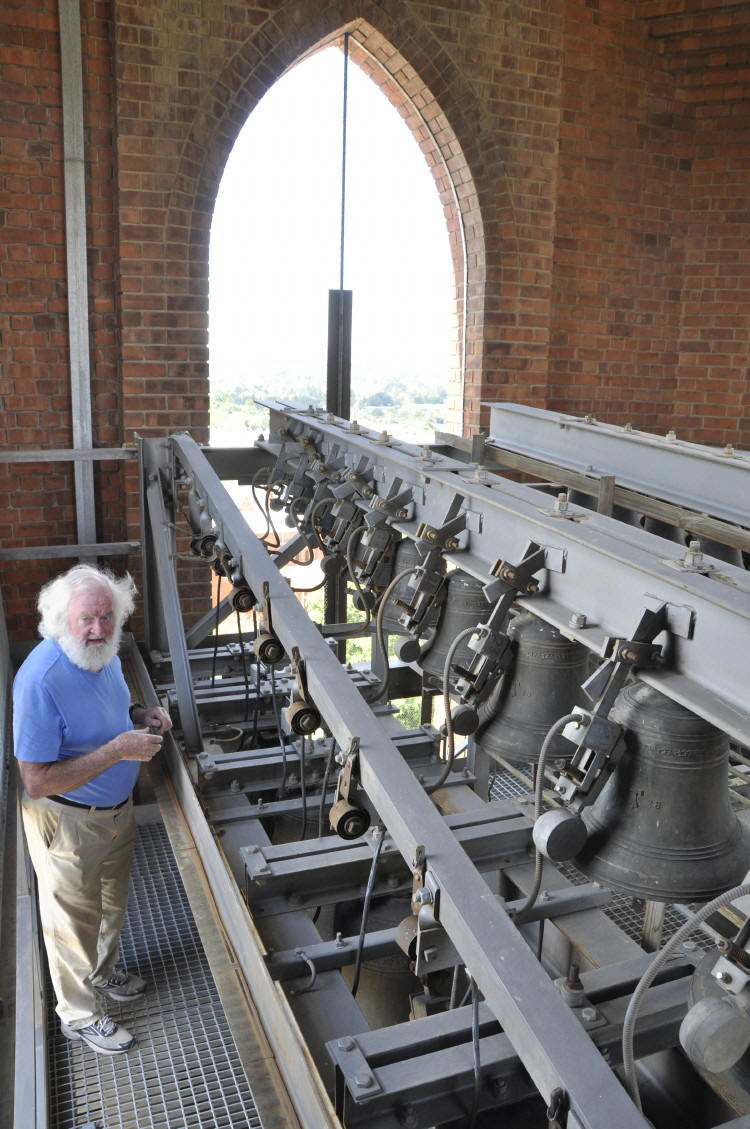
The top tier of bells at Bathurst
Here's an image of our bell - the second full bell from
the right. (And of me, caught rather by surprise by the
camera-lady!) You can see the external electrical striker mechanism on
the side of the bell facing me, and can just make out the tail of the
original internal clapper dangling behind the power lead of the bell
closer to the camera. Note the return springs, closer to me,
disconnected, with their tails pointing skyward. The old
mechanical transmission that let the pneumatic keyboard control the
original clappers is long gone, replaced by the electrical clappers
under MIDI control. The old clappers hang forlornly, loved only by
gravity.
Hear for yourself
Now I mentioned the clappers produce a different sound,
but don't take my word for it - have a listen for yourself. I
think you will be amazed at how two clappers on the same bell can sound
so different.
The bell was recorded digitally in the uncompressed .wav
format using a Rode NT55 studio condenser microphone, a Tascam US-122
USB/MIDI interface and a Toshiba laptop. The recording you are about to
hear has been digitally edited to give three strikes on the internal
(original) clapper, followed by a pause, and then three notes on the
external (electrical) striker. I'm presenting it like that to give you
time to absorb the details of the sounds. No changes to tone were
made during the editing. You may wish to play the file a few times
to become really familiar with the difference in sound. Be sure to
use a device with decent sounding speakers – you may not be able to tell
on portable devices with tiny speakers. And turn the sound up enough to
be able to hear clearly.
Comparison of Internal and External clappers.mp3
I promised in the introduction that new technologies
makes it easy for us to delve into the sounds to see why they sound so
different. So, let's delve!
1. Waveform comparison using the Digital Audio Editor.
Our first tool is the PC-based Digital Audio Editor
(DAE), and it's one freely available. You can think of a DAE as a
word processor for sound. You can delete, edit, drag-&-drop, copy,
move, do anything with sound that you can do with words in your word
processor. And add reverb or special effects, speed up or slow
down, change the tone, add voiceovers, etc, etc. You can download
Audacity for your own use by clicking on this
link.
I used Audacity to record the bells on site on the
laptop, and used it again to edit the recording to produce the
comparison above. Now I'm using it to compare the waveforms of the
two strikes side by side. It's a wonderful bit of software,
especially considering the price (totally free!). In our case
here, we're using it to see how the two soundwaves look on screen.
The external (electrical) clapper is on the left in
the image below. The scale across the top gives the passage of time in
seconds. You will see that the electrical clapper produces more noise
at the instant of strike, then dumps all its sound energy in a very
quick burst, while the energy from the manual internal clapper (right)
decays more slowly and more linearly, and the tail maintains the
traditionally expected bell resonance.
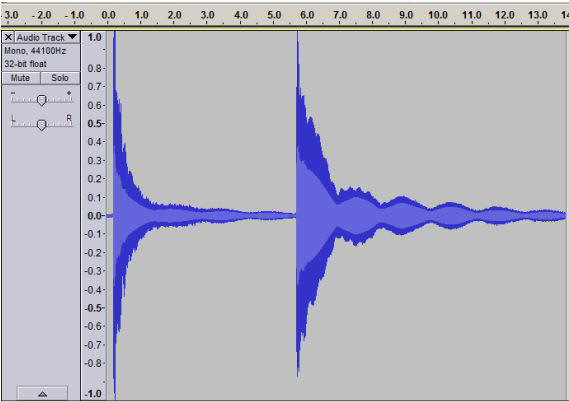
DAE screenshot, showing the different envelope waveforms produced by the
External and Internal clappers
So we've already confirmed that the
decay of the two bell sounds vary differently with time.
2. Spectral (FFT) analysis.
Fast Fourier Transform software allows us to visualise the spectrum
or harmonic content of each note. The remarkable Audacity software
includes FFT analysis in its package of features. Yes, you can do
this at home too! And for free. There's no excuse really, is
there?
I should explain a bit for those not used to analysing sounds.
Firstly, an FFT (Fast Fourier Transform) takes a waveform (recorded
sound in this case) and converts it into the "frequency domain" rather
than the "time domain". (The result is also sometimes called a
"spectrum", because it's like splitting up a light beam into its
composite colours.) So we now see peaks representing the various
partials. The Hum frequency is the peak on the left, just below 600Hz.
The other partials are the peaks that stretch out from that towards the
right. The higher a peak is, the louder it is in the mix of partials
that comprise the sound.
Now, let's take the horizontal line at -48dB as an arbitrary but
convenient loudness threshold. We'll say that peaks louder than that are
significant, while those lower than that are not. On the right hand
image (old clapper), we see 5 peaks above that. They are our old
familiar friends, hum, nominal, tierce, octave and twelfth. (The quint
and several others don't quite make it up to our line.) The bell is a D,
so they are D5, D6, F6, D7 and A7, all concordant as Fminor. Nice.
Now follow the same horizontal line in the left hand spectrum and you'll
see the same 5 partials, plus 5 other peaks, so we've doubled the number
of partials that exceed our threshold. Further, if we carefully analyse
these, we find they are not concordant (the poor old bell tuner is good,
but he ain't God!). Some of the new partials immediately obvious are G7,
C#8, D#8 and G8. Further, they fall in a part of the overall spectrum
where our ears are very sensitive, so they punch well above their weight
in terms of sonic impact. That's why the external clapper sound was so
bad. We've uncovered the bell-tuner's nightmare notes. It's like a
really badly flattened internal clapper would produce, but maybe made
worse by poor location and being too light, too hard or both.
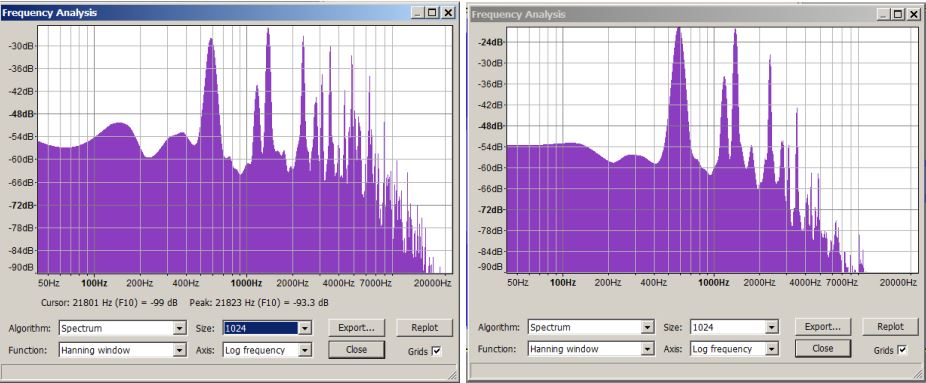
Fast Fourier Transforms showing the partials produced by the external
clapper (left) and the internal clapper (right).
3. WaveAnal
We can go further, but we need some specialist bell
software. Uh-oh, I imagine you thinking, this is gonna prove
expensive! But nope, again free. UK bell researcher Bill
Hibberts created WaveAnal as part of his research program into bell
sounds and generously makes it available for
download.
WaveAnal automates the process of identifying
partials. In the screenshot below, the graph at left shows the
partials in the external striker sound in a manner similar to the FFT we
saw above. In the table at the right, you can see what WaveAnal
made of them. It was puzzled by two very low sounds, possibly the
vehicle noise you can hear in the background in the recording.
WaveAnal has a facility for deleting such spurii, but I've left them in
to illustrate that external noises can try to trick you.
The real data starts at line 3 of the table, where
WaveAnal has identified a partial at 584Hz. It successfully
identifies it as the bell's Hum note, tells us that it is 9 cents flat
of D2 and therefore 2396.2 cents flat of the Nominal. 2400 cents
would be a perfect 2 octaves (24 semitones, 0 cents). The real
data starts at line 3, where WaveAnal has identified a partial at 584Hz.
It successfully identifies it as the bell's Hum note, tells us that it
is 9 cents flat of D2 and therefore 2396.2 cents flat of the Nominal.
(2400 cents, i.e. 24 semitones, 0 cents, would be a perfect 2 octaves.)
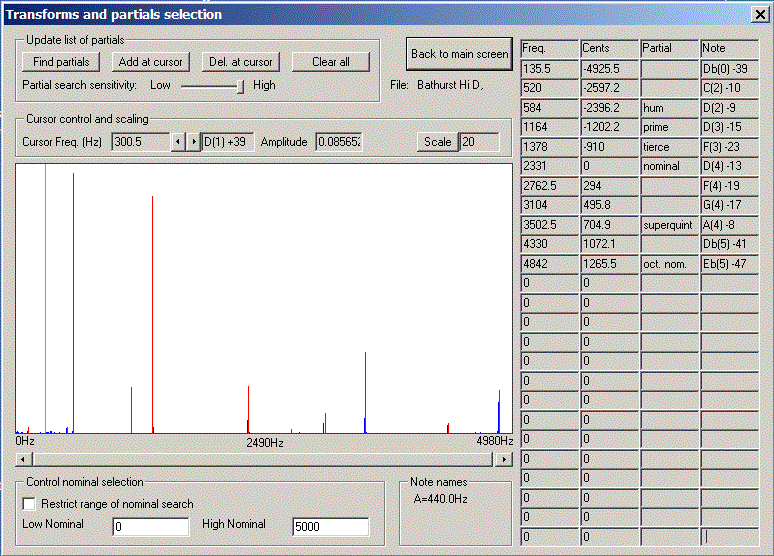
WaveAnal
screenshot, showing the table of partials produced by the external
striker
As we progress down the table, we see all the usual
suspects - prime, tierce, nominal etc - identified and quantified.
WaveAnal isn't so sure about identifying some of the others, but gives
us the ratios needed to identify them if we want to. Note that
WaveAnal hasn't found all of the partials we can see in the left hand
FFT up in section 2; presumably Bill has set the maximum sensitivity at
a point where he figures the partials aren't loud enough to be
significant. Even so, we can see why the bell sounds bad.
How often do you include G, Db and Eb in your Fminor chords?
Especially when the Db and Eb are also extra flat.
4. Decay analysis
But for our purposes, there's a much more exciting
facility offered by WaveAnal - Decay Analysis. It isn't fully
resourced within the program, you need to do a bit of the work yourself,
using an external spreadsheet and graphing package. But hey, they
can be free too! If you don't have Microsoft Excel, download
Open Office. (I used Microsoft
Excel, but Open Office works the same.)
Once you've done some spreadsheet number crunching
and graphing, you end up with results like these below. On the
left, we can see the five melodious partials that WaveAnal identified
from the Internal clapper sound. On the right, we see the nine
partials, not all harmonious, that WaveAnal identified in the external
striker case. In both, they rise quickly at the instant of impact,
left of graph, and decay at various rates as we progress to the right of
graph, one second in time later. (WaveAnal gives us data for more
than a second, but I truncated it there so we could zoom in on the
interesting stuff.)
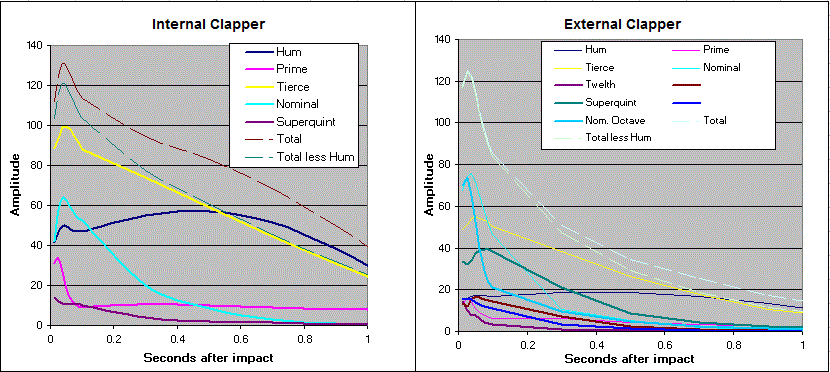
Looking at the left image, we can see that the
Tierce and Nominal are the dominant partials at the start, until the Hum
comes up to vie for supremacy later. But remember the Hum isn't
that audible, so the sound is mostly characterised by Tierce and
Nominal.
In the right image, the external clapper brings out
mostly the Nominal and its Octave at first, with the Tierce and then the
Superquint taking over later. The Hum is very low in the mix,
probably inaudible in any practical sense. Referring back up to
the WaveAnal table, we see that the Nominal Octave is actually 65 cents
sharp of the Nominal (Eb -47cents compared to D -13 cents), so we can
expect some disagreement there! These high partials are a bit like
hot chilli. A little can add some interest to the mix, but too
much makes it inedible.
5. Resynthesis
Now, it struck me, while working with this WaveAnal decay data, that
we can recombine the separate decays to give an overall decay curve.
You do have to be a bit careful here - simply adding the various
partials at any instant will give an overinflated total. The
correct procedure is to find the Root Mean Squared value, sometimes
abbreviated to RMS value. You square each of the instantaneous
values, sum the squares, and take the square root of the lot.
Tedious by hand, but a snack in a spreadsheet.
Then it struck me further that we can also do the same but leaving
out the Hum, on the grounds that the Hum doesn't contribute much if
anything to audibility. So, in the charts above, you'll see two
extra curves called Total and Total less Hum (shown dashed). (A
variant - and we might want to discuss this - would be to "weight" the
Hum value - and maybe other partials too - so that it contributes only
its meaningful share, and not an excessive one. We might call that
Total, weighted. But we'd probably need to do some experimental
work first to establish a weighting scheme that closely modelled
reality.)
Immediately on comparing the two decay charts above, we can see that
both the Total and the Total Less Hum decays are longer in the case of
the internal clapper. Since we have all this data conveniently in
our spreadsheet, it's no great effort to produce a direct comparison
chart featuring just the totals:
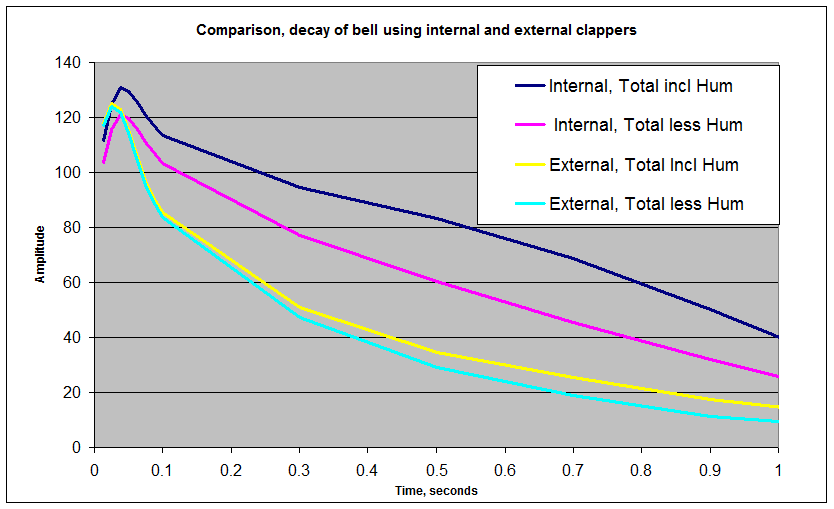
Two things are evident:
- the small difference between the two External clapper traces
(aqua & yellow) reminds us that the Hum is not excited much by the
external striker
- the difference between the two Total Less Hum curves (aqua and
pink) illustrates how much quicker the external clapper energy is
dissipated. If we took the horizontal line at 40 as an
indicator, the decay times differ by a factor of 2:1.
It's usually assumed that a bell decays at a rate decided by the
bell, and not external factors like clappers. But this seems to
suggest otherwise. Perhaps an explanation lies in the low level of
Hum in the External clapper case. The Hum mode is really the
fundamental mode of vibration in the bell (even though the term
Fundamental is sometimes confusingly used for the Prime partial one
octave higher). Should we think of the Hum as the bell's engine
room, without which the bell will splutter and die? Or perhaps it's
enough to note that the Tierce is the longest lived partial after the
Hum and is well audible. We can see in the two decay graphs
further up that, in the Internal case, the Tierce is the major
constituent of the sound, whereas in the External case, two other high
partials are considerably louder. Whatever it is about the
external clapper, it not only discriminates against the Hum, but also
the Tierce, the only pair of partials really capable of sustain.
Wrapping it up
So, we really know much more now about these two situations, the same
bell hit by two different clappers:
- the old internal clapper excites only a few partials
- all these partials are harmonious
- of these partials really only two (plus the Hum) are doing the
lion's share
- the newer external electric clappers excites about twice the
number of partials
- the additional partials are inharmonious among themselves and
with the original partials
- the sound of the bell decays much faster when struck by the
external clapper
- we perceive that as more staccato, probably compounding the
tonal difference.
Why so different?
So why do the clappers make the bell sound so different?
Firstly, the internal clapper is 75 years old and hasn't
been used for maybe half that time. It is probably encrusted with
rust on the old strike surface, and so will probably be more mellow than
usual. A few minutes playing and it would probably brighten up
nicely!
The hammers on the electrical strikers look small to me,
and I wonder, looking at the image above of the bell in question and the
one to its right if there is not a big shift in sizes. That might
be one reason why this particular bell sounds so bad under the
electrical hammer - the manufacturers of the strikers make them in a
limited range of weights, and only one bell in the tier has anything
like a suitable weight hammer?
It's also possible that the electric striker is not
ideally placed. I've also heard it said that an external clapper
has to be heavier than an internal clapper to achieve the same results.
I can't comment as I haven't looked into it. There may well be a
reason we have traditionally rung our bells from within.
It might simply be the case that the external striker's
contact point has been hammered flat and it desperately needs revoicing.
I didn't check that as my reason for being there wasn't related to the
condition of the external clappers. Needless to say, curiosity now
demands I take a peek when there next!
I am a little puzzled by the design of the electrical
clapper hammers. They are essentially cylindrical, with chamfered
ends. A horizontal cylinder will touch a bell shape at only one
point, just like a spherical clapper. But as the cylinder or the
bell contact point wears, the horizontal axis of the wear point can be
expected to grow quickly. So why choose that shape? We
should perhaps direct that question to those who know more about
electrical strikers than I do.
It can only get worse...
Comparing one note of course tells only part of the
story. Imagine now that we play not one note, but say a four note chord
(left and right hands, left and right feet). As each bell note is
really a chord in itself, we now have four chords played at once, with
all their complex harmonics fighting among themselves. This is when it
is really important not to excite partials that are discordant with the
bell itself, let alone with other bells. Four chords can be
challenging, four corrupted chords constitute a nightmare.
Disclaimer
You might perceive I'm waging a one-man-war against
external electrical strikers, but that would be simplistic. I'm
waging war on anything that makes a bell sound less well than it could.
That might be underweight clappers, flattened clappers, improperly
placed clappers or a combination of them all.
I am saying that we need to remember that our bells
sound only as well as our clappers allow them. If your clappers
are letting down the side, have them tended to. If they are doing
a good job, thank them.
I'll leave the last word to the MIDI controller, as it
belts out its startling arrangement of the well-known "Londonderry Air".
To the acoustic faults we've identified in the article, the controller
adds its other remarkable skills, the ability to play in unrelenting
time with unyielding lack of emotion. It's a "tour de force",
literally. Press on the link below - be patient, it'll take a
little time to load. Value those few moments left to you.
And, while it plays, consider my "It can only get worse"
comments above. Would you want to sound like this?
Bathurst-Danny-Boy-External-clappers-Apollo-II-controller.mp3
Further discussion
You'll find a lot of the same material and an
opportunity to discuss issues raised (or that should have been raised)
in the GCNA forum on
technical discussions.
For more on the physics of clapper and bell dynamics:
Bell clapper impact dynamics and the voicing of a carillon
|